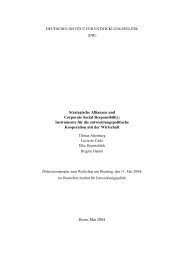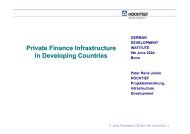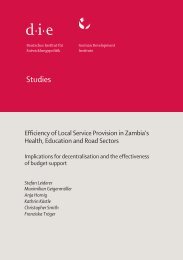Middle East / North Africa and the Millennium Development Goals ...
Middle East / North Africa and the Millennium Development Goals ...
Middle East / North Africa and the Millennium Development Goals ...
Create successful ePaper yourself
Turn your PDF publications into a flip-book with our unique Google optimized e-Paper software.
<strong>Middle</strong> <strong>East</strong> / <strong>North</strong> <strong>Africa</strong> <strong>and</strong> <strong>the</strong> <strong>Millennium</strong> <strong>Development</strong> <strong>Goals</strong><br />
Figure 1: Trends in <strong>the</strong> implementation of MDG1 / Target 1<br />
(Halve <strong>the</strong> proportion of people with less than 1 US$ a day) 3<br />
Source: Designed by <strong>the</strong> author on <strong>the</strong> basis of data in Table A2, Annex<br />
Note: Countries for which <strong>the</strong> available data are ei<strong>the</strong>r markedly contradictory<br />
or unreliable are omitted.<br />
Most of <strong>the</strong> MENA countries, however, will not reach this target if <strong>the</strong>y do<br />
not succeed in reversing present trends (ESCWA 2005). This goes in particular<br />
for Algeria, Yemen, Iraq, Oman, <strong>and</strong> Mauritania, which have been<br />
classified by UNDP as ‘high-priority countries’ with regard to MDG1 –<br />
Algeria, Yemen, Iraq, <strong>and</strong> Oman because <strong>the</strong>y have as yet made no progress<br />
at all in reducing income poverty, <strong>and</strong> Mauritania because income<br />
poverty is so widespread in <strong>the</strong> country that it will be as good as impossible<br />
to fur<strong>the</strong>r step up efforts to reduce it (UNDP 2003a, 43 <strong>and</strong> 53).<br />
3 This <strong>and</strong> <strong>the</strong> following figures show – for reasons of clarity – only relative changes: The<br />
initial level has been normalized to 0. This is problematic in <strong>the</strong> way that <strong>the</strong> diagrams<br />
do not show what absolute changes have occurred <strong>and</strong> how large <strong>the</strong> differences are between<br />
<strong>the</strong> absolute base values for <strong>the</strong> individual countries. Still, this form of presentation<br />
is justified in that <strong>the</strong> MDGs <strong>the</strong>mselves refer to relative changes.<br />
German <strong>Development</strong> Institute 47

















